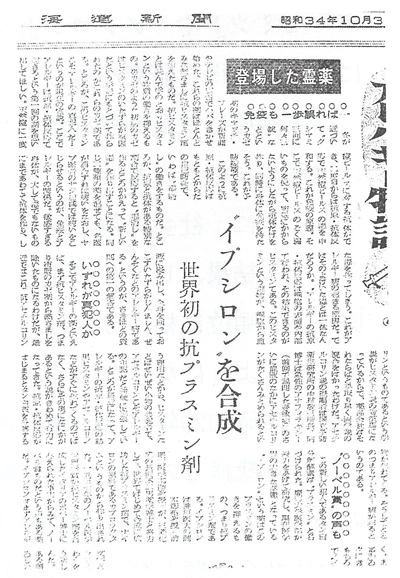It has long been known that when clotting occurs, fibrinogen, a protein in the blood, is converted into fibrin. In 1940, it was discovered that one of the causes of uncontrolled bleeding was the action of “plasmin,” an enzyme that breaks down fibrinogen. Subsequently, a substance that inhibits the action of plasmin in the body, “antiplasmin,” was discovered.
In 1947, along with his colleagues, Dr. Shosuke Okamoto, a lecturer at the Keio University School of Medicine, began to conduct experiments, believing that it might be possible to suppress bleeding by artificially synthesizing an agent with the same action as antiplasmin.
After synthesizing several hundred compounds, they succeeded in extracting epsilon aminocaproic acid, which exhibited the strongest antiplasmin action among all compounds. Based on these results, Daiichi conducted further research to commercialize the product, and after confirming that it had a wide range of clinical applications, it was launched under the name, Ipsilon.

Epsilon was introduced in Japanese newspaper of the time as a "miracle elixir for
curing all diseases"
Initially, the clinical utilization of Ipsilon was very limited because it was an entirely new type of drug formulated under the name of an “antiplasmin agent,” which was unfamiliar during that time.
However, it was gradually recognized as an essential enzyme at the time and gained momentum for theoretical and clinical research as an antiplasmin agent, which resulted in showing its low toxicity, excellent safety, and application not only as an injection but also taken orally.
In 1959, researchers from the Keio University School of Medicine and other university laboratories reported the phenomenon of fibrinolysis at the General Assembly of the Japan Medical Congress.
Meanwhile, Ipsilon was also shown to be effective against acute leukemia, hemophilia, and gynecologic and obstetric bleeding disorders, and its reputation grew rapidly.
In the same year, following the patent application in the United States and the subsequent export of the product, there was a positive response from the U.S. research community. Shortly thereafter, the efficacy of the antiplasmin action of Ipsilon was confirmed internationally.
Ipsilon was such a revolutionary new drug that it was described in newspapers of the time as “an elixir to cure all diseases,” and with the advancement of research, the range of its indications was expanded to include symptoms, such as abnormal bleeding during surgery, side effects during blood transfusions, skin diseases, and inflammatory diseases, such as tonsillitis.
In response to the growing demand, Daiichi developed a highly concentrated 20% Ipsilon intravenous solution suitable for mass use in addition to the previously available 5% Ipsilon intravenous solution. The company also launched easy-to-administer tablets, syrups, and lozenges, making a valuable clinical contribution to the advancement of antiplasmin research.
However, it became evident at that time that large doses of Ipsilon were required to reliably achieve its action.
Daiichi succeeds in developing the even more effective “Transamin®”
.webp?724)
At the time when Tranexamic acid was first released, it was only
available as an injection or capsule
Daiichi’s research team, in collaboration with Dr. Okamoto, who became a professor at the Kobe University Faculty of Medicine, initiated and succeeded in developing trans-4-aminomethylcyclohexane-1-carboxylic acid (tranexamic acid), which exhibited antiplasmin activity at low doses, by combining two epsilon aminocaproic acid trans molecules (one of the two geometric isomers of the double bond of the molecule). In 1965, on its 50th anniversary, Daiichi launched the tranexamic acid products, “Transamin® Injection” and “Transamin® Capsules.”
The indications for Transamin® were extremely wide-ranging, as it was effective not only in the treatment of all bleeding disorders, such as purpura and hemoptysis, but also in cases where corticosteroids and antihistamines were ineffective, such as dermatologic and otolaryngologic inflammatory diseases and adverse reactions during blood transfusions.
That same year in 1965, Transamin® was presented at the International Congress of Physiological Sciences, where it received a great deal of attention and praise from physiologists in various countries.
Even today, in addition to prescription drugs, Transamin® is widely used in over-the-counter drugs, such as general cold medicines, sold by Daiichi Sankyo in Japan.
Daiichi was a pioneer in introducing innovative drugs to society because of many years of continuous and dedicated research and development, and this passion and legacy still exist in Daiichi Sankyo today.